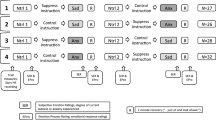Abstract
Mood induction paradigms have become particularly useful in isolating and examining the relationship between mood and cognition relative to depressive vulnerability. The relationship between these two variables was examined using a 2 × 4 design (Diagnostic Group × Condition) whereby subjects classified as depressed (N=72) and nondepressed (N=61) were assigned to one of four conditions. It was shown that the cognitions of clinically depressed individuals were more dysfunctional than those of nondepressed subjects and that they can undergo temporary states of elation in the absence of any significant change in depressive cognition. How these results relate to cognitive theories of emotion is discussed.
Similar content being viewed by others
References
Beck, A. (1967).Depression: Clinical, Experimental, and Theoretical Aspects. New York: Harper & Row.
Beck, A. (1976).Cognitive Therapy and the Emotional Disorders. New York: International Universities Press.
Beck, A., Ward, C. H., Mendelson, M., Mock, J., & Erbaugh, J. (1961). An inventory for measuring depression.Archives of General Psychiatry, 4, 53–63.
Beck, A., Rush, A., Shaw, B., & Emery, G. (1979).Cognitive Therapy of Depression. New York: Guilford.
Blaney, P. (1986). Affect and memory: A review.Psychological Bulletin, 99, 229–246.
Bower, G. H. (1981). Mood and memory.American Psychologist, 36, 129–148.
Hale, W. D., & Strickland, B. R. (1976). The induction of mood states and their effect on cognitive and social behavior.Journal of Consulting and Clinical Psychology, 44, 155.
Hamilton, E., & Abramson, L. (1983). Cognitive patterns and major depressive disorder: A longitudinal study in a hospital setting.Journal of Abnormal Psychology, 92, 173–184.
Hammen, C., Marks, T., Mayol, A., & deMayo, R. (1985). Depressive self-schemas, life stress, and vulnerability to depression.Journal of Abnormal Psychology, 94, 308–319.
Hollingshead, A. (1957).Two Factor Index of Social Position. New Haven, CT: Hollingshead.
Isen, A., & Gorgoglione, J. (1983). Some specific effects of four affect-induction procedures.Personality and Social Psychology Bulletin, 9, 136–143.
Isen, A., Shalker, T. E., Clark, M., Karp, L. (1978). Affect, accessibility of material in memory and behavior: A cognitive loop?Journal of Personality and Social Psychology, 36, 1–13.
Lewinsohn, P., Steinmetz, J., Larson, D., & Franklin, J. (1981). Depression-related cognitions: Antecedent or consequence?Journal of Abnormal Psychology, 90, 213–219.
Nelson, L. D. (1987). Measuring depression in a clinical population using the MMPI.Journal of Consulting and Clinical Psychology, 55, 788–790.
Raps, C., Reinhard, K., & Seligman, M. (1980). Reversal of cognitive and affective deficits associated with depression and learned helplessness by mood elevation in patients.Journal of Abnormal Psychology, 89, 342–349.
Riskind, J., Rholes, W., & Eggers, J. (1982). The Velten mood induction procedure: Effects on mood and memory.Journal of Consulting and Clinical Psychology, 50, 146–147.
Riskind, J., Beck, A., & Smucker, M. (1983).Psychometric properties of the Dysfunctional Attitudes Scale in a clinical population. Paper presented at the World Congress on Behavioral Therapy, Washington, DC.
Snyder, M., & White, P. (1982). Moods and memories.Journal of Personality, 50, 149–167.
Spitzer, R., Endicott, J., & Robins, E. (1978a). Research Diagnostic Criteria: Rationale and reliability.Archives of General Psychiatry, 35, 773–782.
Spitzer, R., Endicott, J., & Robins, E. (1978b).Research Diagnostic Criteria for a Selected Group of Functional Disorders. New York: Biometric Research Unit, New York State Psychiatric Institute.
Strickland, B. R., Hale, W. D., & Anderson, L. K. (1975). Effect of induced mood states on activity and self-reported affect.Journal of Consulting and Clinical Psychology, 43, 587.
Teasdale, J. D., & Fogarty, S. J. (1979). Differential effects of induced mood on retrieval of pleasant and unpleasant events from episodic memory.Journal of Abnormal Psychology, 88, 248–257.
Teasdale, J. D., & Russell, M. (1983). Differential aspects of induced mood on the recall of positive, negative, and neutral words.British Journal of Clinical Psychology, 22, 163–171.
Teasdale, J. D., Taylor, R., & Fogarty, S. J. (1980). Effects of induced elation-depression on the accessibility of memories of happy and unhappy experiences.Behavior Research and Therapy, 18, 339–346.
Weissman, A. (1976).The Dysfunctional Attitude Scale: An inventory designed to measure the relationship between cognitive distortions and emotional disorders, unpublished manuscript. Philadelphia: University of Pennsylvania.
Weissman, A., & Beck, A. (1978).Development and validation of the Dysfunctional Attitude Scale. Paper presented at the meeting of the Association for Advancement of Behavioral Therapy, Chicago.
Velten, E. A. (1968). A laboratory task for induction of mood states.Behavior Research and Therapy, 6, 473–482.
Zajonc, R. (1984). On the primacy of affect.American Psychologist, 39, 117–123.
Zuckerman, M., & Lubin, B. (1965).Manual for the Multiple Affect Adjective Check List. San Diego, CA: Educational and Industrial Testing Service.
Author information
Authors and Affiliations
Rights and permissions
About this article
Cite this article
Nelson, L.D., Stern, S.L. Mood induction in a clinically depressed population. J Psychopathol Behav Assess 10, 277–285 (1988). https://doi.org/10.1007/BF00962551
Accepted:
Issue Date:
DOI: https://doi.org/10.1007/BF00962551




